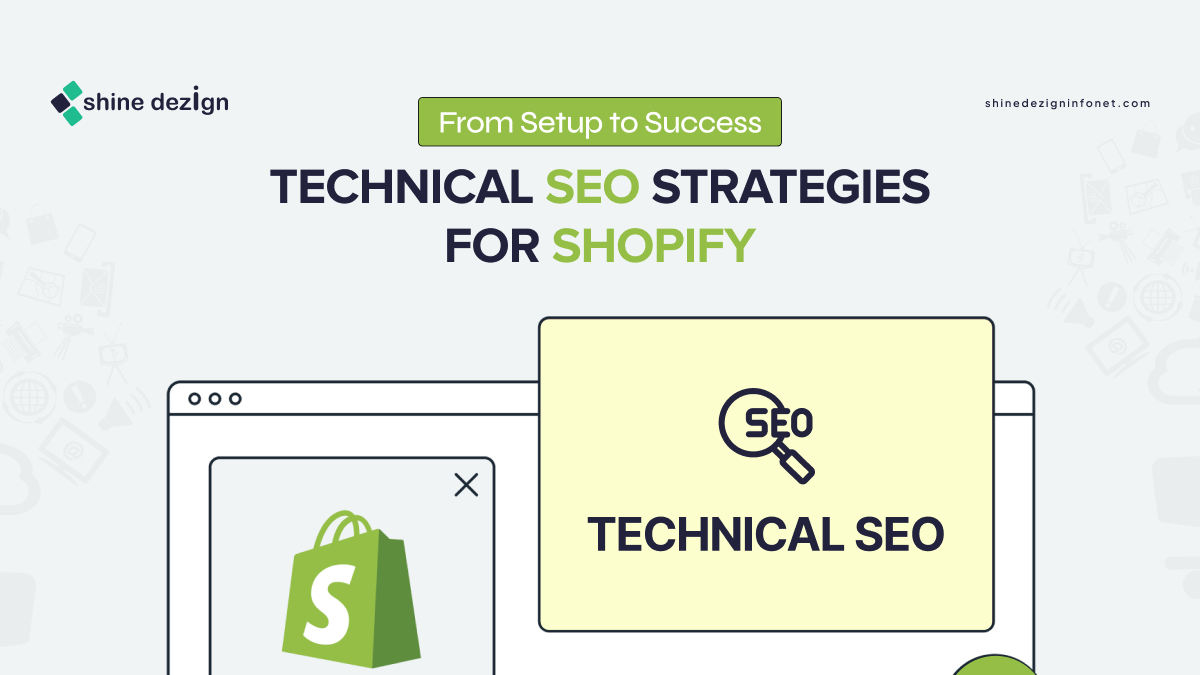Table of Contents
More than 9900 queries are done every 1 sec and around 8.5 billion google searches are made every day in 2024 (Source: demandsage.com ) It no doubt that SEO plays vital role when optimizing your website as this queries becomes keywords that help your websites to rank in Googles Search engine page.
But only keyword optimization will not help to rank your eCommerce store. You need Technical SEO that will enhance the overall performance of your website with low latency.
What is Technical SEO?
 Technical SEO is the process of improvising website’s structure and backend elements to boost its visibility and performance on search engines. Dealing with such SEO projects mostly needs collaboration of web developers and technical SEO professionals, especially if your business has huge traffic.
Technical SEO is the process of improvising website’s structure and backend elements to boost its visibility and performance on search engines. Dealing with such SEO projects mostly needs collaboration of web developers and technical SEO professionals, especially if your business has huge traffic.
Technical SEO audits include analyzing site architecture, security, internal linking, page load speed, etc. to delete points that may hinder search bots from proper crawling, rendering a website and indexing. Let’s check out key factors that come under technical SEO.
Site Architecture
This checks how site content, pages and links are structured and are interconnected to foster effective indexing and crawling by search bots.
Code Quality and Performance
The HTML code quality and structure, page sizes, loading times and overall onsite performance affect how search engines assess and rank your website pages.
Mobile Optimization
As most of the eCommerce traffic comes from mobiles, all website pages must be mobile-friendly, with clear navigation, responsive design, quick load times, and tap targets.
Security Measure
Implementing complete SSL certificate, HTTPS protection, permission protocols, and data encryption to establish the website trust.
Indexation Tools
Using XML sitemaps, robots.txt files, structured data, image alt tags, and canonical tags to optimize crawling can help to boost website performance.
Core Web Vitals
Analyzing metrics which search engine prioritize including first input delay, largest Contentful paint, and cumulative layout shift to upboost website experience.
Why your Store needs Technical SEO?
 Applying technical SEO for Shopify Store includes fine-tuning different factors of ecommerce platform to foster website visibility and search engine rankings. Let’s check why your Shopify store requires technical SEO services.
Applying technical SEO for Shopify Store includes fine-tuning different factors of ecommerce platform to foster website visibility and search engine rankings. Let’s check why your Shopify store requires technical SEO services.
Affect SERP Rankings
One of the main reasons why technical SEO is vital because it directly affects search engine rankings. Search engines like Google continuously keep updating their algorithms to deliver the most updated and user-friendly results to their users. These algorithms consider various technical aspects when determining the web pages rankings.
Therefore, Shopify stores that are optimized technically get higher ranking in search engine results pages (SERPs), driving organic traffic and robust clients to the site.
User Experience
Technical SEO contributes to the user experience of a website. Nowadays, where everything is fast, users expect websites to load seamlessly and quickly across all the devices.
By optimizing technical Factors like mobile responsiveness, website speed, and structured data markup business can create more user-friendly website that keeps visitors engages and encourages them to boost performance.
Outranks Competitors
Every business strives to outrank their competitors or rank above their competitors. Therefore, SEO strategy that incorporates ahead of the competition needs a comprehensive SEO strategy that incorporates a strong focus on technical optimization. A website that is optimized technically stands a better chance of outranking competitors.
Stay on Top of Trends
The importance of technical SEO extends beyond traditional websites to other digital domains like mobile apps, eCommerce development platforms, and even voice search. With the proliferation of voice-activated devices and smart assistants, optimizing for voice search queries needs a better understanding of technical SEO principles like natural language processing and schema markup.
How to set up Technical SEO for your Shopify store?
 Step 1: Streamline Site Structure
Step 1: Streamline Site Structure
 The very first step of setting technical SEO for shopify is to align website structure and navigation involves arranging the content for your Shopify store in a coherent and user-friendly purpose. This helps to boost the user experience but also facilitates smoother crawling and indexing by search engine that is vital SEO factor.
The very first step of setting technical SEO for shopify is to align website structure and navigation involves arranging the content for your Shopify store in a coherent and user-friendly purpose. This helps to boost the user experience but also facilitates smoother crawling and indexing by search engine that is vital SEO factor.
To streamline structure, you need to categorize your products into distinct and clear categories. Also, you need to make sure that your website’s navigation menu is uncluttered and straightforward. Therefore, avoid overwhelming visitors with an excess option.
Moreover, you can also implement breadcrumb navigation on product pages. This helps users in traversing your website and offers a search engine with additional website structure.
Step 2: Set Up Google Search Console
 If you haven’t already, you need to create a Google search console account. As it doesn’t include any heavy charges and is free of cost. This helps to analyze your website’s performance in search results and overall performance of individual pages. Moreover, you can also view errors that Google’s crawler, Googlebot, encounter when visiting your website.
If you haven’t already, you need to create a Google search console account. As it doesn’t include any heavy charges and is free of cost. This helps to analyze your website’s performance in search results and overall performance of individual pages. Moreover, you can also view errors that Google’s crawler, Googlebot, encounter when visiting your website.
 Also, Google search console provides inside look into how Google perceives your websites, you want to utilize this free tools. Also, it can help you to submit pages to Google, monitor google rankings, fix google crawling issues and more.
Also, Google search console provides inside look into how Google perceives your websites, you want to utilize this free tools. Also, it can help you to submit pages to Google, monitor google rankings, fix google crawling issues and more.
Step 3: Add XML sitemap to Google search console
If you are not aware, a sitemap is a file that lists all websites of your website, so that you can allow Google to know how your store is organized Your map functions as a set of instructions so that Google’s bot can easily crawl through your website with less effort.
 Also, for Shopify SEO, the platform makes things easy on Shop owners, all subscribers may receive their very own Shopify sitemap.xml file with links to every blog post, image on your website and product page. Moreover, you can also find your website map by navigating to the root director of your Shopify store i.e. my-store.com/sitemap.xml.
Also, for Shopify SEO, the platform makes things easy on Shop owners, all subscribers may receive their very own Shopify sitemap.xml file with links to every blog post, image on your website and product page. Moreover, you can also find your website map by navigating to the root director of your Shopify store i.e. my-store.com/sitemap.xml.
Step 4: Set up Google Analytics
 You need Google Analytics to track your website traffic effectively. You can also analyze the user engagement and behavior that will help you to analyze your clients’ behaviors, bounce rates, and more. Furthermore, you can also measure individual page performance using metrics like engagement, sessions, time spent and conversions.
You need Google Analytics to track your website traffic effectively. You can also analyze the user engagement and behavior that will help you to analyze your clients’ behaviors, bounce rates, and more. Furthermore, you can also measure individual page performance using metrics like engagement, sessions, time spent and conversions.
 Furthermore, Google Analytic enables you to track your clients journey, check where visitors land, what actions they take and what pages they move to. So set up Google Analytics.
Furthermore, Google Analytic enables you to track your clients journey, check where visitors land, what actions they take and what pages they move to. So set up Google Analytics.
Step 5: Optimize URL Structure
 Optimizing and improving your URL structure includes crafting precise, descriptive and appropriate URL for your Shopify store’s pages. Therefore, a well-structured URL provides both users and search engines with a clear and concise indication of the page’s content. This optimization is vital for search engine optimization as it helps to improve user and website performance.
Optimizing and improving your URL structure includes crafting precise, descriptive and appropriate URL for your Shopify store’s pages. Therefore, a well-structured URL provides both users and search engines with a clear and concise indication of the page’s content. This optimization is vital for search engine optimization as it helps to improve user and website performance.
Additionally, you can add relevant keywords in your URL to indicate the page’s content, helping users and search engines to understand the purpose of the website.
Also, avoid lengthily URL, for instance if you have category page of men t-shirt you can structure your URL like; abc.mystore.shopify.com/products/men_t-shirt
Step 6: Use Robot.txt
When Google’s crawls your website, it will first check the/robot.txt, which is also known as Robot exclusion p robot rotocol. This protocol has the ability to allow or disallow particular web robots to crawl your website, including particular sections or even pages of your website.
 Also, if you wish to prevent bots from indexing your website, or you may wish to block certain bots from crawling your site altogether.
Also, if you wish to prevent bots from indexing your website, or you may wish to block certain bots from crawling your site altogether.
Unfortunately, there are some bots out there with malicious intent- bots that will scrape your spam or content your community forums. If you notice this bad behavior, you will utilize your robot.txt to prevent them from entering your website.
Step7: Secure your site with HTTPS
Securing your Shopify store with Hypertext Transfer Protocol secure helps to maintain end-to-end encryption between your Shopify store and your users. This is important to protect sensitive vital data of your website and also your client’s data.
As an eCommerce business owner, clients can make purchase orders on your website. Insecure websites can get affected quickly resulting in suspicious attacks on your website.
 Therefore, you need to activate SSL certificate offered by shopify for all the stores. Also, you need to configure your Shopify settings to make sure that all versions of your pages are exclusively accessible through HTTPs and not HTTP. Enable shopify setting to redirect all traffic to HTTPS.
Therefore, you need to activate SSL certificate offered by shopify for all the stores. Also, you need to configure your Shopify settings to make sure that all versions of your pages are exclusively accessible through HTTPs and not HTTP. Enable shopify setting to redirect all traffic to HTTPS.
Step 8: Optimize Product Pages
 Enhancing your product pages involves refining the structure and content of your Shopify store’s product listing to boost their appeal to search engines and users. This includes optimizing descriptions, tiles, images and meta data to render them more pertinent, SEO-friendly, and Captivating.
Enhancing your product pages involves refining the structure and content of your Shopify store’s product listing to boost their appeal to search engines and users. This includes optimizing descriptions, tiles, images and meta data to render them more pertinent, SEO-friendly, and Captivating.
Also, you can craft descriptive and precise titles including vital product-related keywords. Also, you can ensure alignment and clarity with search terms your target audience might embed. Furthermore, include descriptive alt text for each image, including target keywords for boosting SEO.
Step 9: Use SEO Apps and Tools
Using SEO apps and tools includes a plethora of apps and software that are personalized to enhance the SEO performance of your Shopify Store. These resources provide automation and optimizations and streamline all the strategies’ tasks.
Main strategies include niche keyword research, site audits, on-page optimization, and performance monitoring. You can also add apps geared towards optimizing your content directly in your Shopify store. These tools optimize titles, images and descriptions to enhance on–page SEO.
Use platforms like Ahrefs, SEMrush for backlink analysis and building. These tools facilitate the identification of high-quality backlink factors and monitoring the existing backlink health.

Step 10: Add Breadcrumb menus
Website breadcrumbs are another vital part of the technical SEO audit. They are the small text path that highlights where a user’s is on a website. They are trails of where a user’s have visited on your website.
They are highlighted in search results which looks like: Home/blog/title
Example:
Types of Breadcrumbs
Hirerachy Based Breadcrumbs
 Hirerachy based breadcrumbs are the common ones as they inform users where they have visited particularly in a website site structure. They highlight the steps in the URL and show users how they are far from the homepage.
Hirerachy based breadcrumbs are the common ones as they inform users where they have visited particularly in a website site structure. They highlight the steps in the URL and show users how they are far from the homepage.
Attributed Based Breadcrumbs
 Attributed based breadcrumbs are mostly found on the eCommerce websites. As you can redirect users for the particular category. For instance; if you own a fashion brand store you can add attribute-based breadcrumbs like; Home/Product/Category/Male/Size/Color
Attributed based breadcrumbs are mostly found on the eCommerce websites. As you can redirect users for the particular category. For instance; if you own a fashion brand store you can add attribute-based breadcrumbs like; Home/Product/Category/Male/Size/Color
History Based Breadcrumbs
 History based breadcrumbs are exactly they sound to be. They follow the history of users visited on the website or Shopify store. For instance: Home/Products/Category/Women/Ethnic wear
History based breadcrumbs are exactly they sound to be. They follow the history of users visited on the website or Shopify store. For instance: Home/Products/Category/Women/Ethnic wear
Step 11: Use Pagination
 In technical SEO for Shopify, pagination has a slightly different role but you can still think of it as a form of business. Pagination utilize code to inform search engine when page with different URL related to each other.
In technical SEO for Shopify, pagination has a slightly different role but you can still think of it as a form of business. Pagination utilize code to inform search engine when page with different URL related to each other.
For example: you may have a content series that you can break up into different chapters or webpages. If you require to make it more seamless for search bots to crawl these pages, you need to use pagination.
Common Technical SEO Issues
 1. Irrelevant Site Indexing
1. Irrelevant Site Indexing
Search for your business keywords or brand on Google. If your website do not rank or is not highlighted in Google’s SERP, then there might be a website indexing problem with your website.
If you want to know if your landing pages and websites are indexed or not your website. All you can do is add “site” in front of the specific URL. You can check in the images below and do it for checking the website indexing.
Image 2: If you URL is index you can see the result in the Google’s SERP as mentioned below.
2. XML Sitemaps
XML Sitemaps help Google bots to understand more about your website pages, so they can crawl your website intelligently. SO, to check you to need to type your domain name and add /sitemap.xml as mentioned below
If your website has a sitemap you will see something related to this, refer the below image
 3. Robot.txt
3. Robot.txt
A missing robots.txt file a big red flag- bit did you know that improper configured robots.txt file can destroy your organic traffic. Therefore, to check the issues with robots.txt.file, type your website URL into the Google browser with /robots/txt/ suffix. and if get a result that highlights User-agent: *Disallow:/”then you havethe problem with your site. You can refer below image to chekc how it appears
 4. Slow Page Speed
4. Slow Page Speed
If your website fails to load quickly, then you will lose your user, or they will access the different websites. Typically, it is considered that your website should take 3 seconds or less to load.

 You need to check page speed for both desktop and mobile. as mentioned in the below images. You need 80+ performance of your website In case it is below 80 you can increase the page speed including browser caching improvement, image optimization/compressions, JavaScript minifying, and server response time improvement. Check the images below to check good page speed insights.
You need to check page speed for both desktop and mobile. as mentioned in the below images. You need 80+ performance of your website In case it is below 80 you can increase the page speed including browser caching improvement, image optimization/compressions, JavaScript minifying, and server response time improvement. Check the images below to check good page speed insights.
5. Broken Links
Good external and internal links highlight both search crawlers and users that you have top-notch content quality. But over the time, content change
Good internal and external links show both users and search crawlers that you have high quality content. Over time, content changes and once-great links break. Broken links interrupts the journey of searchers and reflect low quality content, a factor that can impact page ranking. you can check broken links through your SEO tools like ahrefs or any other broken link checker that are available online.
6. Rel Canonical
Re Canonical informs Google to consolidate pages. This helps to avoid any duplicate content issues by stating the preferred version of the page. In all of the hustle and bustle of developing and creating your page its very possible to forget about this process.
 Therefore, avoid unwanted problems by making sure that rel canonical in the code points at the same page you want to be crawled and indexed by Google.
Therefore, avoid unwanted problems by making sure that rel canonical in the code points at the same page you want to be crawled and indexed by Google.
7. Temporary redirects
A 307 or 302 redirect is temporary, while a 301 redirect is permanent. So, a temporary redirect is for taking down a web page that you will publish again, such as a Diwali sale page or Christmas sale page.
Whereas a 301 redirection states, it will be banned permanently. Therefore, when you use 301 redirects, google will surpass the web page authority of the old page to its new redirect destination, giving a new page boost and making it visible to the users.
Technical SEO Strategies that you should not miss
 Optimize Alt Images
Optimize Alt Images
Image Alt is the text that describes an image to visually impaired search engines and users. It is also a vital SEO factor. Use descriptive alt text that properly reflects the image content.
For instance: If you have uploaded a image of green color shirt it will show as image1.jp instead you can add alt text that can be like green color T shirt.
Implement Breadcrumbs
As breadcrumbs are the navigation that helps users to know the the position of the current page they are accessing within the website hierarchy. They can improve user experience and help search engines understand your website’s hierarchy.
Use Canonical Tag
Canonical Tags particularly the specific version of a page when you have different versions of the same content. This helps to prevent duplicate content obstacles and improve your search engine rankings.
Stay Updated with SEO trends
The SEO world and its techniques are changing continuously and so you need to stay informed about the latest algorithm updates. As AI has changed the SEO techniques so algorithms like E-E-A-T has change the way of marketing your websites. There, you need to stay updated about the latest trends and ensure that your website strives successfully in the competitive market.
Utilize Content Delivery Network
A Content Delivery Network (CDN) will help to improve your website performance and speed, especially for users that are located in different locations and regions. A CDN seamlessly distributes your website’s content through multiple servers across the globe.
Prioritize Accessibility
Make sure that your website is more and quick accessible. You can adhere to accessibility guidelines like web content accessibility guidelines to improve user experience and boost the ranking of your search engines rankings.
Summing Up
This guide has offered a detail Technical SEO for Shopify. You check the above Technical SEO checklist that can help you get more visitors to your website. Always remember that technical SEO is not about covering these things. It’s also more for making your website better for people. So, following the above tips and strategies you can strive for growth and better SEO optimization for your website. To further optimize your store, consider hiring Shopify experts who can help you take your website to the next level.






















